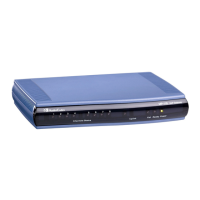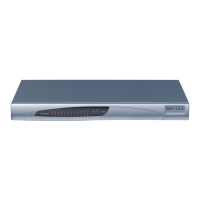11.8.2 Remote UA behind NAT
If the remote User Agent with which the device needs to communicate with is located
behind NAT, the device can resolve the problem of activating the RTP/RTCP/T.38 streams
to an invalid IP address / UDP port.
To resolve this NAT traversal issue, the device offers the following features:
RTP No-Op packets according to the avt-rtp-noop draft - see 'No-Op Packets' on page
129
The figure below illustrates a typical network architecture where the remote UA is located
behind NAT:
Figure 11-13: Remote UA behind NAT
11.8.2.1 First Incoming Packet Mechanism
If the remote device resides behind a NAT device, it’s possible that the device can activate
the RTP/RTCP/T.38 streams to an invalid IP address / UDP port. To avoid such cases, the
device automatically compares the source address of the first received incoming
RTP/RTCP/T.38 stream with the IP address and UDP port of the remote device when the
session was initially opened. If the two are not identical, then the destination IP address of
the outgoing RTP packets is set to the source IP address of the first incoming packet. The
RTP, RTCP and T.38 can thus have independent destination IP addresses and UDP ports.
To enable NAT resolution using the First Incoming Packet mechanism, set the DisableNAT
ini file parameter to 1.
The EnableIpAddrTranslation and EnableUdpPortTranslation parameters allow you to
specify the type of compare operation that occurs on the first incoming packet. To compare
only the IP address, set EnableIpAddrTranslation to 1, and EnableUdpPortTranslation to 0.
In this case, if the first incoming packet arrives with only a difference in the UDP port, the
sending addresses won’t change. If both the IP address and UDP port need to be
compared, then both parameters need to be set to 1.
11.8.2.2 No-Op Packets
The device's No-Op packet support can be used to verify Real-Time Transport Protocol
(RTP) and T.38 connectivity, and to keep NAT bindings and Firewall pinholes open. The
No-Op packets are available for sending in RTP and T.38 formats.
You can control the activation of No-Op packets by using the ini file parameter
NoOpEnable. If No-Op packet transmission is activated, you can control the time interval in
which No-Op packets are sent in the case of silence (i.e., no RTP or T.38 traffic). This is
done using the ini file parameter NoOpInterval. For a description of the RTP No-Op ini file
parameters, see 'Networking Parameters' on page 461.

